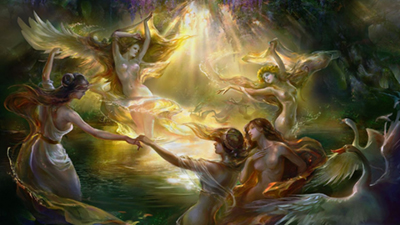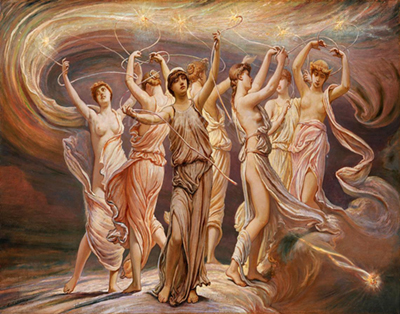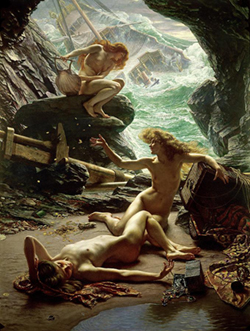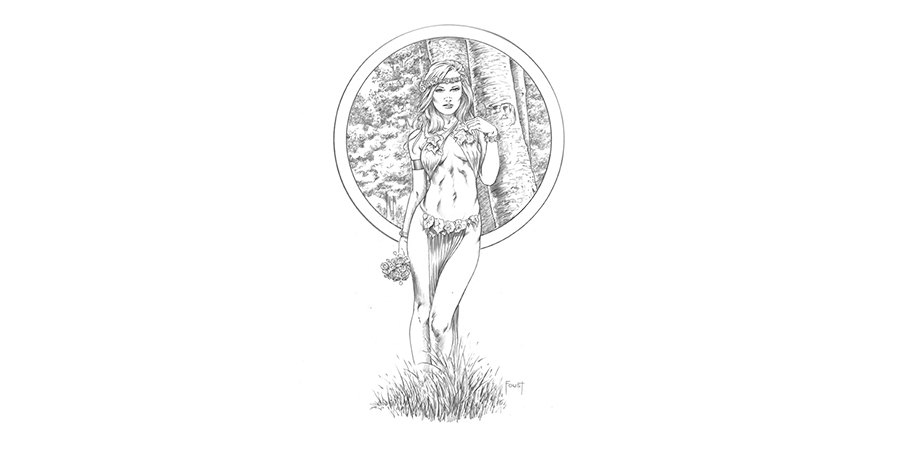In Greek mythology, nymphs were minor female deities, or goddesses, associated with nature. Typically pictured as beautiful girls or young women, they could live for a very long time but were not immortal (able to live forever). Most nymphs were the daughters of Zeus, the leader of the gods, or of other gods.
They generally had gentle natures and acted with kindness toward humans. Some stories, however, tell of nymphs who lured unsuspecting mortals to their deaths. Acheloös, to some degree a generalized river god, often figures as the father, but many others are also invoked, depending on the region. While the ultimate mortality of nymphs was debated among ancient authors it was clear to the ancients that they enjoyed a superhuman lifespan far outstripping that of mortal men and women.
 Overall the nymph is a highly ambiguous figure. Though sexually desirable, she is usually free of the familial restrictions applied to mortal women and can rarely be fully domesticated. Nymphs may be sexually promiscuous, and they can act as the aggressors in ephemeral affairs with mortals. Furthermore, such affairs can be deadly to the male, as the cases of Daphnis and Rhoikos show. Nymphs regularly personify and inhabit springs, rivers, and lakes. One of their main mythic and cultic functions is to provide fresh water. A female who is part of Artemis’ or Dionysos’ mythic retinues or who takes part in the care of infant gods is likely to be a nymph.
Overall the nymph is a highly ambiguous figure. Though sexually desirable, she is usually free of the familial restrictions applied to mortal women and can rarely be fully domesticated. Nymphs may be sexually promiscuous, and they can act as the aggressors in ephemeral affairs with mortals. Furthermore, such affairs can be deadly to the male, as the cases of Daphnis and Rhoikos show. Nymphs regularly personify and inhabit springs, rivers, and lakes. One of their main mythic and cultic functions is to provide fresh water. A female who is part of Artemis’ or Dionysos’ mythic retinues or who takes part in the care of infant gods is likely to be a nymph.
Nymphs, because of their association with springs, are often healing deities. Healing gods as a rule are close to a water source, preferably one that is heated or has interesting mineral properties, such as the sulfurous springs of the Anigrid nymphs at Samikon. The cult places of nymphs, are as a rule associated with natural features: rivers, caves, and springs.
The Muses, Charites, and Horai are groups closely allied to the nymphs, and they fulfill under other names many of the functions otherwise attributed to nymphs (e.g., causing the crops to ripen or producing inspiration). They are primarily cultic entities, though we do find some mythic mentions of their choruses and their function as escorts of the gods and goddesses. There can be little doubt that the Muses and the Charites developed from the same ancestral stock as the nymphs and are in fact more specialized members of the same general group.
Both had localized cults that spread within limited areas, yet they became known on a Panhellenic scale at an early date. The Muses’ function as the catalysts of divine inspiration correlates with aspects of the more humble phenomenon of nympholepsy, and their associations with mountains, springs, and the pastoral milieu are definitely nymphlike.Like the nymphs, they act as companions and attendants of certain Olympian deities, particularly Aphrodite and Hermes. They, too, are goddesses of vegetative abundance and moisture as well as creative inspiration.
They are also correspondences between Charites and nymphs, both appear in iconography, depicted as dancing triads. Charites and nymphs occasionally appear together in both poetry and iconography. The Horai, or Seasons, said by Hesiod to be daughters of Zeus and Themis, resemble the Charites but are closer to simple personifications of natural abundance. They, too, act as escorts of the gods, and Homer describes them opening the gates of the sky for Hera. Like the nymphs and Charites, they are associated with weddings, childcare, and choruses. Nymphs often act as nurses for young gods and heroes (as the Okeanids do in the Theogony) or as helpers in a hero’s quest.
Nymphs also play a minor role in several quest myths, as an intermediate source of helpful information or objects.
Nymphs and their environment
There are different types of nymphs, each associated with a particular natural environment. The most well-known types of Nymphs are:
- Naiads – These are freshwater nymphs who are associated with springs, rivers, and streams. They are often depicted as beautiful maidens who live in or near the water.
- Dryads – These are tree nymphs who are associated with forests and groves. They are said to live within the trees themselves and are often depicted as shy and elusive creatures.
- Oreads – These are mountain nymphs who are associated with mountains and rocky outcroppings. They are often depicted as strong and athletic, and are sometimes associated with hunting or archery.
- Hamadryads – These are a specific type of tree nymph who are said to be born with their trees and die when their trees die. They are deeply connected to the natural world and are sometimes seen as protectors of their trees.
- Nereids – These are sea nymphs who are associated with the Mediterranean Sea. They are often depicted as beautiful, graceful creatures who can swim and dance effortlessly.
- Oceanids – These are freshwater nymphs who are associated with the oceans and other bodies of water. They are often depicted as powerful and regal, with the ability to control the tides and currents.
- Anthousai – These are flower nymphs who are associated with meadows and fields. They are said to be born from flowers and are often depicted as gentle, playful creatures who love to dance and sing.

Another specific landscape feature associated with nymphs is the cave. Caves large or small are the most common cult site of the nymphs, although by no means belonging exclusively to them. Caves had a symbolic value out of proportion to their minor economic value: they regularly appear in mythology as the birthplaces and homes of deities and monsters, the sites for sexual intercourse (usually of an illicit character), and the spots where heroic infants are exposed.
Certain places characterized by abundant water, shade, and vegetation, often semicultivated vegetation, were imbued with the nymphs’ presence. These places were above all pleasing to the senses; they invited passersby to stop and refresh themselves. The traditional motif of the locus amoenus, or pleasant spot, goes back to Hesiod’s description of his midday rest beside a cooling spring.Hesiod himself does not mention the nymphs, but many later versions of the locus amoenus include them.
The simple idea that a hamadryad nymph is coeval with her tree is well attested in archaic and classical literature. The word hamadryad itself, a compound of hama, “together with,” and drus, “tree,” “oak,” contains this idea. Plutarch suggests that the word was first used by Pindar, but the idea is attested as early as the Homeric Hymn to Aphrodite (1.4.1).45 Sources of widely varying date elaborate the basic motif of the hamadryad into narratives about heroes’ encounters with these tree-dwelling nymphs. Sometimes, the hero observes that the tree is in imminent danger and preserves it, to be rewarded by the nymph. (Not surprisingly, sex comes into the picture here.) Other times, the hero wickedly cuts the tree in spite of the nymph’s pleas and is duly punished. Both stories are moral exemplars; the latter is probably the elder of the two, since it fits the ancient paradigm of hubris punished.
Homer, for his part, uses the characteristic triad of spring, cave, and vegetation, particularly poplar trees, to describe the lovely abodes of Kalypso, the Ithakan nymphs, and the nymphs of Goat Island, opposite the Kyklopes. The classic example of a locus amoenus is Plato’s description in the Phaedrus of a pleasant spot beside the Ilissos River. Sokrates and his companions reach a certain place marked by a plane tree and a spring, a shrine for the nymphs and Acheloös (the generalized river god who often appears with them in cultic contexts). Both the landscape and the time of day are significant. The plane trees and their cool shade, the riverbank, the grassy slope, the sound of cicadas all combine to create an inviting place to rest. The hour of midday, when one is inclined to seek shade beneath a tree, is also the hour when divine epiphanies are most likely.
Such a place as this is never without a divine presence, which accounts for the appeal of the landscape and its strong influence upon the susceptible observer. As Sokrates says, “Truly the place seems divine [theios], so do not be surprised if I often seem to be numpholęptos as my discourse progresses, for I am already almost uttering dithyrambics.” The term numpholęptos, or “seized by the nymphs,” has several possible meanings, but in this case it describes an access of poetic inspiration brought on by Sokrates’ surroundings. Contrary to his usual custom of questioning his interlocutors, he is voluble, expressing himself in an elevated poetic fashion. The close relationship between poetic inspiration and prophecy in Greek culture is well known, and nympholepsy could also be manifested as a prophetic gift. Any spot that is refreshingly cool, green, and pleasing to the eye might be
the abode of nymphs.
From Good Nymphs to Demons and Fallen Angels
The object of comparisons between the ancient nymphs and the neraïdes is first of all to determine whether the neraïdes are in any sense the “descendants” of the classical nymphs. The second object is, from the classicist’s point of view, to determine what light the modern material can shed upon the ancient. Since ancient sources are biased away from the viewpoints of women, the uneducated, the poor, and the rural, those for whom the cult of the nymphs was most important, we may profit by looking at modern material collected from analogous populations.
In the modern era, the neraïdes are only one category of a large population of supernatural beings known as (e)xôtika, “things outside or beyond.” Some of these beings have apparently classical origins, to judge from their names and functions, including Gello, the child-killing demon, and Charos, the lord of the dead; others are not as easily placed, such as the kallikántzaroi (goblins) or the vrykólakes (revenants or vampires). These exist alongside a host of saints, angels, and demons who belong to Christian cosmology.
All of the exôtika have been profoundly influenced by Orthodox Christianity, and it is worth emphasizing that the neraïda exists within a Christian matrix of beliefs. This fact alone accounts for some significant differences between nymph and neraïda. Most informants in collected material on the exôtika indicate that the neraïda, like other exôtika, belongs to or is somehow allied with the devil. The neraïda is more often a cause of misfortune and disease or death than prosperity and health, while precisely the opposite was true for the nymph. Even a cursory look at the parallels between the neraïda and the classical nymph is suggestive of continuity.
Many of the characteristics of the nymphs in antiquity are equally applicable to neraïdes: they haunt springs, caves, mountains, and groves of trees; they have the form of beautiful young women; they dance and weave; and so on. Even more significant, postclassical sources can be marshaled to demonstrate the transition from nymph to neraïda. As the centuries passed, the more sinister and disturbing aspects of nymph beliefs in classical Greece were selected for emphasis.

For example, the phenomenon of nympholepsy, which in archaic and classical times was a positive or, at worst, ambiguous event (1.3), eventually became a grievous attack. In the fourth century, we begin to find possession or inspiration by gods associated in both popular and intellectual opinion with pathological states. A medical text attributed to Aristotle suggests that those in whom black bile is both excessive and hot may be “affected by the diseases of madness or enthusiasm, which accounts for the Sibyls and Bakides [nymph-inspired prophets] and all inspired persons.” While the cult of the nymphs remained strong in the Roman Imperial period, nympholepsy itself was widely considered an illness or madness with no positive connotations of inspiration. According to the lexicographer Festus, “Popular belief has it that whoever sees a certain vision in a fountain, that is, an apparition of a nymph, will go quite mad.
These people the Greeks call numpholêptoi and the Romans, lymphatici.” The shift toward negative interpretations of “seizure by the nymphs” seems to have been largely completed during the Byzantine period, when the classical nymphs were syncretized with malignant demons, both the fallen angels of Christian orthodoxy and older Greek demons like the lamiai and gelloudes. A Byzantine demonological text called The Testament of Solomon depicts a beautiful female called Onoskelis (Donkey-leg), who lurks in caves and gorges and entice men sexually only to strangle them.
A much later magical text gives a protective spell against the demons of night and day, including “the Fair One of the Mountains or the Nereid Onoskelis.” Neraïdes who are otherwise beautiful but with the lower legs of donkeys or goats are sometimes mentioned in modern Greek material. The Byzantine dialogue Peri Daimonôn attributed to Michael Psellus identifies the ancient nymphs as a class of demons: “those which live in damp places and are fond of a softer way of life make themselves into the resemblance of women, wherefore these were also called in a feminine way by the sons of the Greeks Naiads, Nereids, and Dryades.”
While intellectuals argued that demons had no gender but merely assumed an outward male or female appearance, popular belief continued to recognize certain classes of demons who were not only female but whose activities were marked for gender: the Gello type attacked pregnant women and babies, while the Onoskelis type seduced, then harmed men. Both of these activities have been attributed to neraïdes in the modern period.
The Byzantines and later observers through the seventeenth century, then, identified a specific kind of female demon with the nymph of the classical world. Furthermore, the ancient nymphs were inevitable candidates for such a transformation to the status of demons because of the well-known phenomenon of nympholepsy, which already in pre-Christian antiquity had lost its positive connotations. In antiquity, as in all later periods, nympholepsy could be manifested either as an abduction, a literal “rapture,” or as an aberrant mental or physical state observed in an individual. According to Nilsson, daimones like the neraïdes survived because they resisted Christianity more successfully than the Olympians, being more basic to people’s daily lives.
There is much truth to this, but observation of the role of exôtika in modern Greece suggests that certain classical daimones survived because they also fit comfortably within the developing Christian context. Concern with the malignant influence of evil spirits and demons and the dangers of interaction with them was a feature of the Hellenistic world, but it seems only to have increased with the introduction of Christianity and its emphatic division of the supernatural into the categories of good and evil.
In ancient times, it was believed that a person who cut down a tree that housed a nymph would be punished by the gods! Maybe we need such awareness especially today at a time when we are so ruthlessly destroying nature.
*This article is an excerpt from the book:
- Greek Nymphs: Myth, Cult, Lore Jennifer Larson OXFORD UNIVERSITY
- www.newworldencyclopedia.org/entry/Nymph

